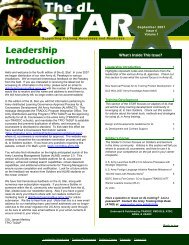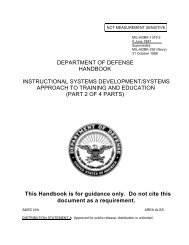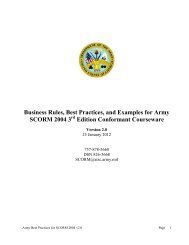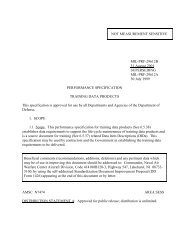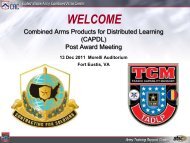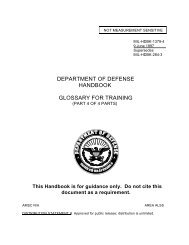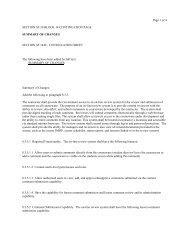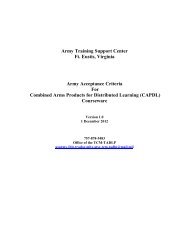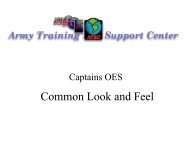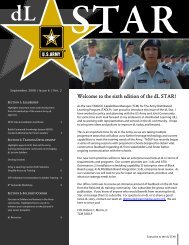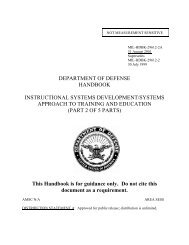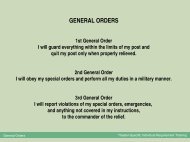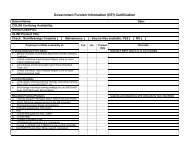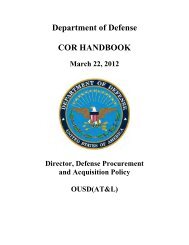dlxxi contract - U. S. Army Training Support Center
dlxxi contract - U. S. Army Training Support Center
dlxxi contract - U. S. Army Training Support Center
You also want an ePaper? Increase the reach of your titles
YUMPU automatically turns print PDFs into web optimized ePapers that Google loves.
through MIL-HDBK-1379-4. The following descriptions are provided to define the<br />
requirements of this <strong>contract</strong> IAW those DoD performance specifications.<br />
C.7.1.1 Traditional-based instructional material.<br />
C.7.1.1.1 Traditional instructor-led training products consist of the development<br />
functions normally associated with the SAT process for courses and/or lessons as<br />
identified in TR 350-70 including the Program of Instruction (POI) and Course<br />
Management Plan (CMP). These products will be based on previously conducted<br />
government approved front-end analysis results or developed by the <strong>contract</strong>or. The<br />
materials produced must meet the objectives within the allotted time.<br />
C.7.1.1.2 <strong>Training</strong> Program Structure Document, DI-ILSS-81521, for traditional<br />
instructor-led courseware (CDRL A006). This is the part of the design function of the<br />
SAT process for traditional-based courseware. It shall include the POI and CMP and<br />
contain the information specified in the DID and TR 350-70. For TATS it shall include<br />
training data for the total force. The POI instructional hours approved by the Government<br />
will be the number of instructional hours required for development of training conduct<br />
support documents. The latest version of the Program of Instruction Management<br />
Module (POIMM) shall be used. POIMM will be furnished as GFM.<br />
C.7.1.1.3 <strong>Training</strong> conduct <strong>Support</strong> Document, DI-ILSS-81523, and Test Packages, DI-<br />
ILSS-81525, for traditional-based courses. The <strong>contract</strong>or shall provide lesson plans<br />
(CDRL A011), trainee guides (CDRL A0012), on-the-job training (OJT) handbooks<br />
(CDRL A013), instructional visual aids (CDRL A014), training material change data<br />
(CDRL A015), and appropriate testing materials such as test items, tests [( pretests,<br />
posttests, comprehension checks, end-of-lesson tests, end-of-unit tests, etc.)( see<br />
paragraph C.4.5)], and test administration materials (CDRL A007) as ordered by the<br />
delivery order. These training data products, when combined, shall constitute standalone<br />
courses of instruction for instructor-led or self-paced use. These products are<br />
based on the number of instructional hours which will comprise the final course materials<br />
with one hour equating to a unit of instruction.<br />
C.7.1.2 Interactive Multimedia Instruction (IMI) Courseware.<br />
C.7.1.2.1 Instructional Media Design Package (IMDP) (CDRL A005),<br />
http://dtswg.msosa.dmso.mil/revisiona/81520a.pdf DI-ILSS-81520. The <strong>contract</strong>or shall<br />
provide the IMDP for either print or IMI or a combination of both per delivery orders. The<br />
IMDP and its accompanying prototype lesson(s) are the most important document in the<br />
design and development of IMI. All prerequisite information (front-end analyses)<br />
required will be provided by the government or will be completed by the <strong>contract</strong>or. The<br />
IMDP shall break out the number of instructional hours for the course being designed.<br />
The hours approved by the Government will serve as the basis for development of the<br />
instructional media package. The content areas will be divided into units, topics, and<br />
lessons of reasonable length as approved by the government. Questions and/or<br />
exercises will be embedded in all units, topics, and lessons. The IMDP will also contain<br />
design strategies for electronically administered criterion referenced performance and/or<br />
performance based IMI tests to include a diagnostic pretest, progress checks (check on<br />
learning), and two versions of a final comprehensive test for each lesson, module, and<br />
course (see paragraph C.4.5). The sample/prototype lesson(s) shall not normally



